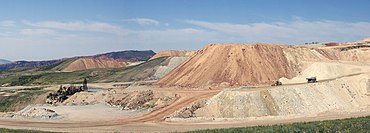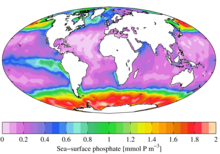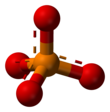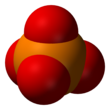Molar Mass Of Phosphoric Acid
 | |||
| |||
| Names | |||
|---|---|---|---|
| Systematic IUPAC name Phosphate[one] | |||
| Identifiers | |||
| CAS Number |
| ||
| 3D model (JSmol) |
| ||
| Beilstein Reference | 3903772 | ||
| ChEBI |
| ||
| ChemSpider |
| ||
| Gmelin Reference | 1997 | ||
| MeSH | Phosphates | ||
| PubChem CID |
| ||
| UNII |
| ||
| InChI
| |||
| SMILES
| |||
| Backdrop | |||
| Chemical formula | PO 3− 4 | ||
| Molar mass | 94.9714 g mol−ane | ||
| Conjugate acid | Monohydrogen phosphate | ||
| Except where otherwise noted, data are given for materials in their standard state (at 25 °C [77 °F], 100 kPa). Infobox references | |||
In chemistry, a phosphate is an anion, salt, functional group or ester derived from a phosphoric acid. It most commonly ways orthophosphate, a derivative of orthophosphoric acrid H
3 PO
4 .
The phosphate or orthophosphate ion [PO
4 ] 3−
is derived from phosphoric acid by the removal of three protons H +
. Removal of one or two protons gives the dihydrogen phosphate ion [H
2 PO
four ] −
and the hydrogen phosphate ion [HPO
iv ] 2−
ion, respectively. These names are too used for salts of those anions, such as ammonium dihydrogen phosphate and trisodium phosphate.
-

H
3 PO
4
Phosphoric
acid -
![[H 2PO 4]− Dihydrogen phosphate](https://upload.wikimedia.org/wikipedia/commons/thumb/d/db/2-dihydrogenphosphate-3D-balls.png/152px-2-dihydrogenphosphate-3D-balls.png)
[H
two PO
4 ] −
Dihydrogen
phosphate -
![[HPO 4]2− Hydrogen phosphate](https://upload.wikimedia.org/wikipedia/commons/thumb/8/87/1-hydrogenphosphate-3D-balls.png/123px-1-hydrogenphosphate-3D-balls.png)
[HPO
four ] 2−
Hydrogen
phosphate -
![[PO 4]3− Phosphate](https://upload.wikimedia.org/wikipedia/commons/thumb/b/b0/0-phosphate-3D-balls.png/120px-0-phosphate-3D-balls.png)
[PO
4 ] three−
Phosphate
In organic chemical science, phosphate or orthophosphate is an organophosphate, an ester of orthophosphoric acid of the form PO
four RR′R″ where ane or more hydrogen atoms are replaced by organic groups. An instance is trimethyl phosphate, (CH
3 )
3 PO
iv . The term as well refers to the trivalent functional grouping OP(O-)
three in such esters.
Orthophosphates are especially important amongst the various phosphates because of their key roles in biochemistry, biogeochemistry, and ecology, and their economic importance for agriculture and industry.[2] The addition and removal of phosphate groups (phosphorylation and dephosphorylation) are key steps in cell metabolism.
Orthophosphates can condense to course pyrophosphates.
Chemical properties [edit]
The phosphate ion has a tooth mass of 94.97 yard/mol, and consists of a central phosphorus atom surrounded past 4 oxygen atoms in a tetrahedral system. It is the conjugate base of the hydrogen phosphate ion H(PO
4 ) ii−
, which in plough is the cohabit base of the dihydrogen phosphate ion H
two (PO
four ) −
, which in turn is the conjugate base of orthophosphoric acid, H
3 PO
4 .
Many phosphates are soluble in h2o at standard temperature and pressure. The sodium, potassium, rubidium, caesium, and ammonium phosphates are all water-soluble. Most other phosphates are just slightly soluble or are insoluble in water. Every bit a dominion, the hydrogen and dihydrogen phosphates are slightly more soluble than the corresponding phosphates.
Equilibria in solution [edit]

In h2o solution, orthophosphoric acrid and its three derived anions coexist according to the dissociation and recombination equilibria below[3]
| Equilibrium | Dissociation abiding K a [four] | pThousand a |
|---|---|---|
| H3POiv ⇌ H 2 PO − 4 + H + | K a1 = [ H + ] [ H 2 PO − 4 ] / [ H 3 PO 4 ] ≈ vii.five × 10−3 | pM a1 = ii.14 |
| H ii PO − four ⇌ HPO 2− 4 + H + | Thou a2 = [ H + ] [ HPO ii− 4 ] / [ H two PO − 4 ] ≈ 6.2 × 10−8 | pOne thousand a2 = 7.20 |
| HPO ii− 4 ⇌ PO 3− 4 + H + | K a3 = [ H + ] [ PO 3− 4 ] / [ HPO 2− 4 ] ≈ 2.14 × 10−13 | pK a3 = 12.37 |
Values are at 25°C and 0 ionic strength.
The pK a values are the pH values where the concentration of each species is equal to that of its conjugate bases. At pH one or lower, the phosphoric acid is practically undissociated. Around pH 4.seven (mid-way betwixt the outset two pM a values) the dihydrogen phosphate ion, [H
2 PO
iv ] −
, is practically the but species present. Around pH 9.eight (mid-manner betwixt the second and third pChiliad a values) the monohydrogen phosphate ion, [HPO
4 ] 2−
, is the but species present. At pH 13 or higher, the acid is completely dissociated as the phosphate ion, (PO
4 ) iii−
.
This means that salts of the mono- and di-phosphate ions tin be selectively crystallised from aqueous solution past setting the pH value to either 4.7 or ix.8.
In outcome, H
3 PO
4 , H
2 (PO
four ) −
and H(PO
4 ) 2−
bear as carve up weak acids considering the successive pChiliad a differ by more than 4.
Phosphate tin can course many polymeric ions such as pyrophosphate, (P
ii O
7 ) 4−
, and triphosphate, (P
3 O
10 ) 5−
. The diverse metaphosphate ions (which are unremarkably long linear polymers) have an empirical formula of (PO
3 ) −
and are found in many compounds.
Biochemistry of phosphates [edit]
In biological systems, phosphorus tin be constitute equally free phosphate anions in solution (inorganic phosphate) or spring to organic molecules every bit various organophosphates.
Inorganic phosphate is generally denoted Pi and at physiological (homeostatic) pH primarily consists of a mixture of [HPO
4 ] 2−
and [H
2 PO
four ] −
ions. At a neutral pH, as in the cytosol (pH = seven.0), the concentrations of the orthophoshoric acid and its iii anions have the ratios
- [ H
two PO −
4 ] / [ H
3 PO
four ] ≈ vii.five × x4 - [ HPO two−
iv ] / [ H
2 PO −
iv ] ≈ 0.62 - [ PO 3−
4 ] / [ HPO two−
iv ] ≈ two.14 × ten−vi
Thus, just [H
2 PO
4 ] −
and [HPO
four ] 2−
ions are nowadays in significant amounts in the cytosol (62% [H
ii PO
4 ] −
, 38% [HPO
4 ] 2−
). In extracellular fluid (pH = seven.4), this proportion is inverted (61% [HPO
4 ] 2−
, 39% [H
ii PO
4 ] −
).
Inorganic phosphate can be present as well equally of pyrophosphate anions [P
two O
7 ] 4−
, which can give orthophosphate by hydrolysis:
- [P
2 O
7 ] 4−
+ H2O ⇌ two [HPO
4 ] 2−
Organic phosphates are normally found in the form of esters every bit nucleotides (east.g. AMP, ADP, and ATP) and in Dna and RNA. Gratuitous orthophosphate anions tin can be released past the hydrolysis of the phosphoanhydride bonds in ATP or ADP. These phosphorylation and dephosphorylation reactions are the immediate storage and source of energy for many metabolic processes. ATP and ADP are frequently referred to as loftier-energy phosphates, as are the phosphagens in musculus tissue. Similar reactions exist for the other nucleoside diphosphates and triphosphates.
Bones and teeth [edit]
An important occurrence of phosphates in biological systems is as the structural textile of bone and teeth. These structures are fabricated of crystalline calcium phosphate in the form of hydroxyapatite. The hard dense enamel of mammalian teeth may comprise fluoroapatite, a hydroxy calcium phosphate where some of the hydroxyl groups have been replaced by fluoride ions.
Medical and biological research uses [edit]
The medicinal type (salt) of phosphorus is phosphate. Some phosphates, which aid cure many urinary tract infections, are used to make urine more acidic. To avoid the development of calcium stones in the urinary tract, some phosphates are used.[5] For patients who are unable to get enough phosphorus in their daily diet, phosphates are used as dietary supplements, usually considering of certain disorders or diseases.[five] Injectable phosphates can only be handled by a health care provider.[v]
Constitute metabolism [edit]
Plants take up phosphorus through several pathways: the arbuscular mycorrhizal pathway and the straight uptake pathway.
Agin health effects [edit]
Hyperphosphatemia, or a high blood level of phosphates, is associated with elevated mortality in the general population. Hyperphosphatemia is generally acquired past phosphate food additives, as phosphates that are naturally nowadays in food are not completely absorbed past the gastrointestinal tract. Phosphates induce vascular calcification, and a loftier concentration of phosphates in blood was constitute to exist a predictor of cardiovascular events.[six]
Phosphates are ordinarily used equally additives in industrially candy food and fast food. Fast food and ready-to-consume processed foods are the main contributors of the rising consumption of phosphate amongst the population. Phosphates additives are likewise commonly found in flavoured soft drinks besides as sure dairy products.[six]
Production [edit]
Geological occurrence [edit]


Railroad train loaded with phosphate rock, Métlaoui, Tunisia, 2012
Phosphates are the naturally occurring form of the chemical element phosphorus, found in many phosphate minerals. In mineralogy and geology, phosphate refers to a stone or ore containing phosphate ions. Inorganic phosphates are mined to obtain phosphorus for use in agriculture and industry.[2]
The largest global producer and exporter of phosphates is Morocco. Within North America, the largest deposits lie in the Bone Valley region of central Florida, the Soda Springs region of southeastern Idaho, and the coast of North Carolina. Smaller deposits are located in Montana, Tennessee, Georgia, and South Carolina. The small island nation of Nauru and its neighbor Banaba Island, which used to have massive phosphate deposits of the best quality, have been mined excessively. Stone phosphate tin also exist found in Arab republic of egypt, Israel, Palestine, Western Sahara, Navassa Island, Tunisia, Togo, and Jordan, countries that take large phosphate-mining industries.
Phosphorite mines are primarily found in:
- Due north America: United States, specially Florida, with lesser deposits in North Carolina, Idaho, and Tennessee
- Africa: Morocco, People's democratic republic of algeria, Egypt, Niger, Senegal, Togo, Tunisia.
- Middle East: Saudi arabia, Jordan, State of israel, Syrian arab republic, Iran and Iraq, at the town of Akashat, near the Jordanian edge.
- Central Asia: Kazakhstan
- Oceania: Australia, Makatea, Nauru, and Banaba Island
In 2007, at the current rate of consumption, the supply of phosphorus was estimated to run out in 345 years.[seven] However, some scientists idea that a "summit phosphorus" would occur in 30 years and Dana Cordell from Institute for Sustainable Futures said that at "current rates, reserves will be depleted in the next 50 to 100 years".[8] Reserves refer to the corporeality assumed recoverable at electric current market place prices. In 2012 the USGS estimated world reserves at 71 billion tons, while 0.nineteen billion tons were mined globally in 2011.[9] Phosphorus comprises 0.1% by mass of the average rock[x] (while, for perspective, its typical concentration in vegetation is 0.03% to 0.2%),[11] and consequently there are quadrillions of tons of phosphorus in World'southward 3×1019-ton chaff,[12] albeit at predominantly lower concentration than the deposits counted as reserves, which are inventoried and cheaper to extract. If it is assumed that the phosphate minerals in phosphate stone are mainly hydroxyapatite and fluoroapatite, phosphate minerals contain roughly 18.v% phosphorus past weight. If phosphate rock contains around twenty% of these minerals, the boilerplate phosphate rock has roughly 3.seven% phosphorus past weight.
Some phosphate stone deposits, such as Mulberry in Florida,[13] are notable for their inclusion of significant quantities of radioactive uranium isotopes. This is a concern because radioactivity can be released into surface waters[14] from application of the resulting phosphate fertilizer.
In December 2012, Cominco Resources appear an updated JORC compliant resource of their Hinda project in Congo-Brazzaville of 531 meg tons, making information technology the largest measured and indicated phosphate deposit in the world.[15]
In July 2022 Red china announced quotas on phosphate exportation.[16]
The largest importers in millions of metric tons of phosphate are Brazil 3.ii, India two.9 and the USA i.6.[17]
Mining [edit]
The iii principal phosphate producer countries (People's republic of china, Kingdom of morocco and the United States) account for virtually 70% of world production.
| Land | Production (millions kg) | Share of global production (%) | Reserves (millions kg) |
|---|---|---|---|
| People's democratic republic of algeria | 1,300 | 0.54 | ii,200,000 |
| Australia | 2,700 | 1.17 | 1,100,000 |
| Brazil | 4,700 | 3.00 | ane,600,000 |
| China | 95,000 | 44.83 | 3,200,000 |
| Egypt | five,000 | two.47 | 2,800,000 |
| Republic of finland | 995 | - | ane,000,000 |
| India | 1,480 | 0.49 | 46,000 |
| Republic of iraq | 200 | 0.09 | 430,000 |
| Israel | 2,810 | i.48 | 57,000 |
| Hashemite kingdom of jordan | 9,220 | 3.36 | 800,000 |
| Kazakhstan | ane,500 | 0.72 | 260,000 |
| United mexican states | 558 | 0.76 | 30,000 |
| Morocco and Western Sahara | 35,500 | 13.45 | 50,000,000 |
| Peru | 4,000 | 1.79 | 210,000 |
| Russia | 13,100 | five.sixty | 600,000 |
| Saudi Arabia | half-dozen,500 | one.48 | 1,400,000 |
| Senegal | 3,420 | 0.45 | fifty,000 |
| South Africa | 2,100 | 0.99 | 1,400,000 |
| Syria | two,000 | 0.34 | i,800,000 |
| Togo | 800 | 0.45 | xxx,000 |
| Tunisia | 4,110 | one.79 | 100,000 |
| Uzbekistan | 900 | - | 100,000 |
| United states | 23,300 | 12.37 | 1,000,000 |
| Vietnam | iv,650 | one.21 | xxx,000 |
| Other countries | one,140 | 1.17 | 840,000 |
| Total | 227,000 | 100 | 71,000,000 |
Environmental [edit]


Relationship of phosphate to nitrate uptake for photosynthesis in diverse regions of the ocean. Notation that nitrate is more often limiting than phosphate. See the Redfield ratio.
In ecological terms, because of its important role in biological systems, phosphate is a highly sought after resources. Once used, information technology is often a limiting food in environments, and its availability may govern the rate of growth of organisms. This is generally true of freshwater environments, whereas nitrogen is more than frequently the limiting nutrient in marine (seawater) environments. Add-on of high levels of phosphate to environments and to micro-environments in which it is typically rare can have significant ecological consequences. For case, blooms in the populations of some organisms at the expense of others, and the collapse of populations deprived of resources such as oxygen (see eutrophication) can occur. In the context of pollution, phosphates are i component of total dissolved solids, a major indicator of h2o quality, but not all phosphorus is in a molecular form that algae can interruption downwards and swallow.[19]
Calcium hydroxyapatite and calcite precipitates can be found around leaner in alluvial topsoil.[20] Every bit dirt minerals promote biomineralization, the presence of bacteria and clay minerals resulted in calcium hydroxyapatite and calcite precipitates.[20]
Phosphate deposits can comprise significant amounts of naturally occurring heavy metals. Mining operations processing phosphate rock can get out tailings piles containing elevated levels of cadmium, pb, nickel, copper, chromium, and uranium. Unless carefully managed, these waste material products can leach heavy metals into groundwater or nearby estuaries. Uptake of these substances past plants and marine life tin can lead to concentration of toxic heavy metals in food products.[21]
Encounter also [edit]
- Diammonium phosphate - (NHfour)iiHPO4
- Disodium phosphate – NaiiHPO4
- Fertilizer
- Hypophosphite – H
2 (PO
2 ) −
- Metaphosphate – (PO north
iii) - Monosodium phosphate – NaH2PO4
- Organophosphorus compounds
- Ouled Abdoun Basin
- Phosphate – OP(OR)3, such as triphenyl phosphate
- Phosphate conversion coating
- Phosphate soda, a soda fountain drinkable
- Phosphinate – OP(OR)Rii
- Phosphine – PR3
- Phosphine oxide – OPRthree
- Phosphinite – P(OR)Rtwo
- Phosphite – P(OR)3
- Phosphogypsum
- Phosphonate – OP(OR)2R
- Phosphonite – P(OR)2R
- Phosphorylation
- Polyphosphate – (HPO
iii )
n - Pyrophosphate – (P
2 O
vii ) 4−
- Sodium tripolyphosphate – Na5P3Ox
References [edit]
- ^ "Phosphates – PubChem Public Chemic Database". The PubChem Project. The states: National Center of Biotechnology Information.
- ^ a b "Phosphate Primer". Florida Industrial and Phosphate Enquiry Institute. Florida Polytechnic University. Archived from the original on 29 August 2017. Retrieved 30 March 2018.
- ^ Campbell, Neil A.; Reece, Jane B. (2005). Biology (Seventh ed.). San Francisco, California: Benjamin Cummings. p. 65. ISBN0-8053-7171-0.
- ^ Kipton J. Powell, Paul Fifty. Brown, Robert H. Byrne, Tamás Gajda, Glenn Hefter, Staffan Sjöberg, Hans Wanner (2005): "Chemical speciation of environmentally meaning heavy metals with inorganic ligands. Part one: The Hg 2+
, Cl−, OH−, CO 2−
iii , SO ii−
4 , and PO 3−
4 aqueous systems". Pure and Applied Chemistry, volume 77, effect 4, pages 739–800. doi:10.1351/pac200577040739 - ^ a b c "Phosphate Supplement (Oral Route, Parenteral Route) Description and Brand Names - Mayo Clinic". www.mayoclinic.org . Retrieved 2020-xi-20 .
- ^ a b Ritz, Eberhard; Hahn, Kai; Ketteler, Markus; Kuhlmann, Martin K.; Mann, Johannes (January 2012). "Phosphate additives in food--a wellness risk". Deutsches Ärzteblatt International. 109 (four): 49–55. doi:10.3238/arztebl.2012.0049. ISSN 1866-0452. PMC3278747. PMID 22334826.
- ^ Reilly, Michael (May 26, 2007). "How Long Will it Last?". New Scientist. 194 (2605): 38–9. Bibcode:2007NewSc.194...38R. doi:ten.1016/S0262-4079(07)61508-five.
- ^ Leo Lewis (2008-06-23). "Scientists warn of lack of vital phosphorus every bit biofuels raise need". The Times.
- ^ U.S. Geological Survey Phosphate Rock
- ^ U.Due south. Geological Survey "Phosphorus Soil Samples" (PDF).
- ^ Floor Anthoni. "Abundance of Elements". Seafriends.org.nz. Retrieved 2013-01-10 .
- ^ American Geophysical Union, Fall Coming together 2007, abstruse #V33A-1161. Mass and Composition of the Continental Crust
- ^ Central Florida Phosphate Industry: Environmental Bear on Statement. Vol. 2. U.s.a.. Environmental Protection Agency. 1979.
- ^ C. Michael Hogan (2010). "Water pollution". In Marking McGinley and C. Cleveland (Washington, DC.: National Council for Science and the Environment) (ed.). Encyclopedia of Earth. Archived from the original on 2010-09-sixteen.
- ^ "Updated Hinda Resource Proclamation: Now world'due south largest phosphate deposit (04/12/2012)". Cominco Resources. Archived from the original on 2016-x-05. Retrieved 2013-05-03 .
- ^ "China issues phosphate quotas to rein in fertiliser exports - analysts". Reuters. 15 July 2022.
- ^ "Top countries for Phosphate Fertilizer Imports".
- ^ "PHOSPHATE ROCK, usgs" (PDF).
- ^ Hochanadel, Dave (Dec x, 2010). "Limited amount of total phosphorus actually feeds algae, study finds". Lake Scientist. Retrieved June 10, 2012.
[B]ioavailable phosphorus – phosphorus that tin can be utilized by plants and bacteria – is only a fraction of the total, according to Michael Brett, a UW engineering professor ...
- ^ a b Schmittner KE, Giresse P (1999). "Micro-ecology controls on biomineralization: superficial processes of apatite and calcite atmospheric precipitation in Quaternary soils, Roussillon, France". Sedimentology. 46 (iii): 463–76. Bibcode:1999Sedim..46..463S. doi:10.1046/j.1365-3091.1999.00224.ten. S2CID 140680495.
- ^ Gnandi, One thousand.; Tchangbedjil, Thou.; Killil, K.; Babal, K.; Abbel, E. (March 2006). "The Impact of Phosphate Mine Tailings on the Bioaccumulation of Heavy Metals in Marine Fish and Crustaceans from the Littoral Zone of Togo". Mine Water and the Surround. 25 (1): 56–62. doi:10.1007/s10230-006-0108-4. S2CID 129497587.
External links [edit]
![]()
Wikimedia Commons has media related to Phosphates.
- Us Minerals Databrowser provides data graphics covering consumption, product, imports, exports and price for phosphate and 86 other minerals
- Phosphate: analyte monograph – The Clan for Clinical Biochemistry and Laboratory Medicine
Molar Mass Of Phosphoric Acid,
Source: https://en.wikipedia.org/wiki/Phosphate
Posted by: pedersenworign.blogspot.com




0 Response to "Molar Mass Of Phosphoric Acid"
Post a Comment